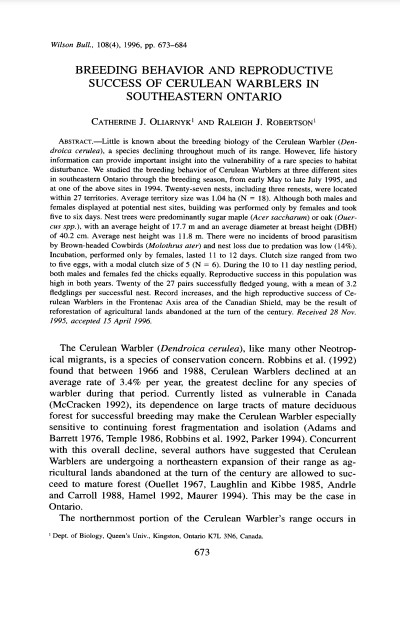Breeding behavior and reproductive success of cerulean warblers in Southeastern Ontario
Bosque Modelo:
Eastern Ontario
Temática:
Gestión forestal
Tipo de documento:
Artículo científico
Resumen
Little is known about the breeding biology of the Cerulean Warbler (Dendroica cerulea), a species declining throughout much of its range. However, life history
information can provide important insight into the vulnerability of a rare species to habitat disturbance. We studied the breeding behavior of Cerulean Warblers at three different sites in southeastern Ontario through the breeding season, from early May to late July 1995, and at one of the above sites in 1994. Twenty-seven nests, including three renests, were located within 27 territories. Average territory size was 1.04 ha (N = 18). Although both males and females displayed at potential nest sites, building was performed only by females and took five to six days. Nest trees were predominantly sugar maple (Acer saccharum) or oak (Ouercus spp.), with an average height of 17.7 m and an average diameter at breast height (DBH) of 40.2 cm. Average nest height was 11.8 m. There were no incidents of brood parasitism by Brown-headed Cowbirds (Molofhrus ater) and nest loss due to predation was low (14%). Incubation, performed only by females, lasted 11 to 12 days. Clutch size ranged from two to five eggs, with a modal clutch size of 5 (N = 6). During the 10 to 11 day nestling period, both males and females fed the chicks equally. Reproductive success in this population was high in both years. Twenty of the 27 pairs successfully fledged young, with a mean of 3.2 fledglings per successful nest. Record increases, and the high reproductive success of Cerulean Warblers in the Frontenac Axis area of the Canadian Shield, may be the result of reforestation of agricultural lands abandoned at the turn of the century.
Información Bibliográfica
Autor:
Oliarnyk, CJ and RJ Robertson.
Revista:
The Wilson Bulletin
Año:
1996
N°:
4
País :
Canadá
Páginas:
673 - 684
Volumen:
108
Idioma:
Ingles
Palabras claves
Model forest, Adaptatation, Monitoring





